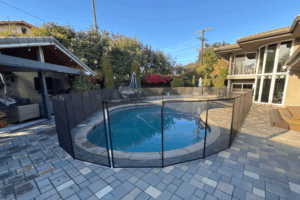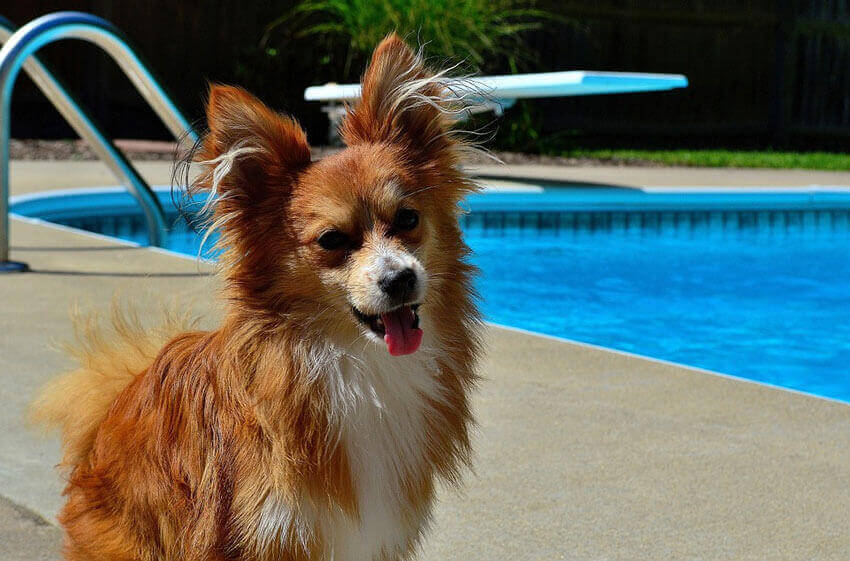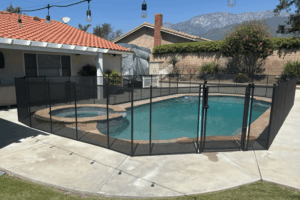
Should You Replace Your Pool Fence or Just Upgrade the Parts?
Wondering if your pool fence needs a full replacement or just a few upgraded parts? Learn how to inspect your system and restore safety without overspending.
Home > How to Train Your Dog to Keep Off the Pool Cover

Dogs aren’t just man’s best friend: they’re a part of the family. There are more than 78 million dogs living as pets in the United States, and from the time they’re first brought home, it can be a real struggle to keep them out of trouble. This is especially true if they share the same space as the more than 10 million residential pools in the United States. So just how do you give your pup the most room to run around and keep them safe at the same time? It can all come down to training.
The kind of risks between your dog and pool partially depend on the type of pool cover you use. If you have a leaf pool cover, or another cover not designed to support their weight, it can actually be dangerous! Hundreds of dogs every year meet a tragic end in residential pools. The training you give your dog and the safety barriers you erect are the best ways to keep that from happening!
Luckily, some pool owners choose mesh pool covers like those produced at All-Safe. These covers are designed to support the full weight of two adults. If you allow your pets to play or run across your cover, your dog will cause damage to the cover over time. It’s best to break this habit early, or else they may continue to stress the material season after season. Here’s how to do it…
One of the best ways to keep your dog off the pool cover is to train him to respond to your voice. If your dog knows to come whenever you call, you can get his attention anytime he starts venturing toward the water.
This technique is a very simple one, but if you do it right it can be very effective — in all kinds of situations. Not only will it help you get your dog away from the pool cover, but it will also make it easier to get him back if he runs away on a walk or escapes your backyard.
If you want to train your dog to come when you call, you’ll need to invest in the two “T’s”: time and treats. Start by taking your dog into a quiet room. Take a few steps away from him and say a command like “here” or “come” — anything you would say to get him to approach you. If he does, give him a treat and lots of love; if he doesn’t make sure he sees the treat, and then give it to him once he’s at your side.
Repeat this process over and over, until your dog comes to associate the command with receiving rewards. You should also challenge him by practicing in more distracting environments, such as a loud, crowded room. Finally, practice this command while outside, calling the dog anytime he gets near the pool cover. If you’ve trained him properly, he should turn from the pool cover and head right to your side.
When you are in the yard with the family, it can be easy to watch everything and use commands to keep your dog off the pool cover. But of course, you can’t be with your dog every second of the day. How can you be sure that she’s safe when you’re at work, or out with friends, or simply not in the pool area?
Many dog trainers encourage pet owners to establish boundaries with their furry companions. This certainly takes some time, but it helps your dog learn which lines she cannot cross, whether it’s getting on the furniture or stepping onto the pool cover.
Your pet will learn boundaries simply through force of habit. So, if you want your dog to stay away from the pool cover, you need to habitually show her that the pool is an area where she does not go. To do this, take your dog on a walk around the backyard twice a day (ideally first thing in the morning and right before bedtime).
As you walk around the pool area, make sure to take your dog up to the pool cover and have her walk alongside it. If she tries to step onto the cover, give her a firm (but not painful) pull on the leash and say “no.”
After a few weeks of this practice, your dog will understand that there is an invisible line around the pool cover — a line that she cannot cross. Continue your walks for a few weeks more, only this time without the leash. She should understand that the pool is not a part of her territory, which will keep the dog off the pool cover.
For some of us, training our dog to avoid the pool cover is one tough battle. Maybe your schedule is booked solid, and there’s simply no time for training. Maybe you have a particularly hyper and hard-to-train pooch. Whatever the reason, sometimes the best way to keep your dog off the pool cover is by putting something in the way.
There are many safety solutions you can use to deter your dog from going near the pool. You can install a pool alarm, which alerts you whenever someone steps into the pool area. You can outfit your dog with a remote control collar that sprays him with water or citronella when he gets too close to the pool. But in our opinion, the best way to make sure your dog is off the pool cover is by fencing it off.
Putting a mesh safety fence around your swimming pool is an effective way to help protect all your family members — whether they have two legs or four. For example, a mesh fence from All-Safe is customizable to suit pools of any size or shape and made of durable that’s tough to rip and very difficult to climb. This simple, beautiful barrier will keep your dog away from the pool area, eliminating the risk of him climbing onto the pool cover.
If you want to make sure your furry friends are safe from the swimming pool, All-Safe Pool Fence & Covers is here to help! Call your local dealer today to get a free, on-site consultation and to learn how you can make your swimming pool safer.

Wondering if your pool fence needs a full replacement or just a few upgraded parts? Learn how to inspect your system and restore safety without overspending.

Pool safety doesn’t have to mean overspending. Explore smart, cost-effective ways to secure your pool area, including durable DIY fence kits from All-Safe.

Wondering if you can install a pool fence without drilling into your deck? We break down your options and explain how All-Safe’s removable fencing keeps your pool secure with minimal impact.
Enter your zip code to locate an independent installer in your area
Enter your zip code to locate an independent installer in your area
Enter in your zip code to let us know where your pool is located.
Due to the many variations in monitors, phones, and browsers, color samples and product examples may appear different on different screens. Computers and mobile devices are not all calibrated equally and color reproduction on the Internet is not precise. The same is true for printed items such as brochures and other sales literature.
In addition, the colors of our products photograph differently under different lighting conditions. For example, photos taken in full sunlight will vary from photos taken on a cloudy or overcast day. Similarly, shadows from nearby objects can affect the color and transparency of our products. If a precise color or specific shade is important, please inspect the actual color of your product prior to installation.
Many of our products’ materials are not available through typical stores and vendors and therefore must be custom manufactured specifically for our use. In order to control costs and provide you with the best value possible, our raw materials are produced in large batches and can often take several months to receive. The colors of our materials can, and often do, vary slightly from batch to batch. Although we make every effort to minimize color variations, we cannot be responsible for these differences when they occur. If a precise color or specific shade is important, please inspect the actual color of your product prior to installation.
For example, we use the name “putty” to describe some of our products. Your idea of the color “putty” may be different than someone else’s idea of “putty”. In addition, products may have the same color name but may not be the exact same color. For example, we have different shades of “black”. Please do not order using color names as your only guide. If a precise color or specific shade is important, please inspect the actual color of your product prior to installation.
If it is important that your product be an exact color or shade, it is highly recommended that you inspect the actual product prior to its installation and address any concerns with your local independent installer. Most independent installers do not offer refunds or accept returns due to color variations.